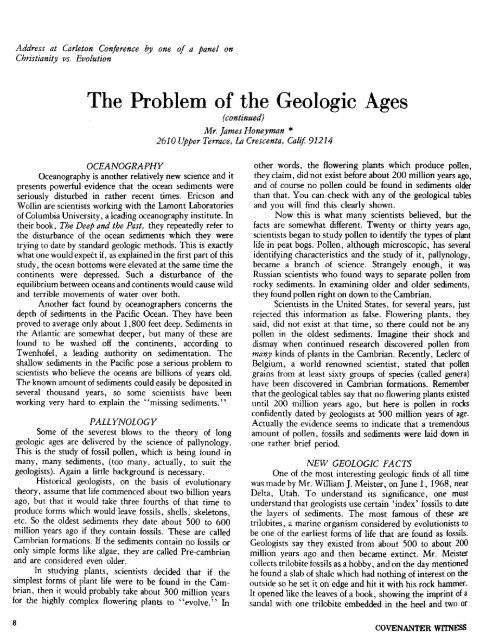- Page 1 and 2:
OLUME LXXXVI NO. 1 JANUARY 6, 1971
- Page 3 and 4:
THE COVENANTER WITNESSOfficial orgr
- Page 5 and 6:
Glimpses of the Religious WorldRev.
- Page 7 and 8:
REV. J. PAUL WILSON WRITES:Nicosia,
- Page 9 and 10:
sinners may require clarification i
- Page 11 and 12:
SomeThis and That inAs the New Year
- Page 13 and 14:
THECOVENANTEROfficial organ of theP
- Page 15 and 16:
Glimpses of the Religious WorldRev.
- Page 17 and 18:
Students ElectedTo "Who's Who..."Tw
- Page 19 and 20:
George Gillespie's View ofThe Media
- Page 21 and 22:
The Children'sPrayer Brings A Lost
- Page 23 and 24:
a father, will he give him a stone?
- Page 25 and 26:
NOTICE OF CALLOn November 22, 1970,
- Page 27 and 28:
STATEMENT BY THE PRESIDENTTHE WHITE
- Page 29 and 30:
THE COVENANTER WITNESSOfficial orga
- Page 31 and 32:
Glimpses of the Religious WorldRev.
- Page 33 and 34:
1970 — Many voices, many bannersR
- Page 35 and 36:
OPPOSE PLAN OF UNIONOpposition to t
- Page 37 and 38:
The Children'sCorner^ffTRUDY'S SECR
- Page 39 and 40:
Catechism it is said, "Justificatio
- Page 41 and 42:
our services. Dr. Felker has been a
- Page 43 and 44:
Home for the Aged in Hot Springs."
- Page 45 and 46:
THE COVENANTER WITNESSOfficial orga
- Page 47 and 48:
Glimpses of the Religious WorldRev.
- Page 49 and 50:
an aid to missions. In country afte
- Page 51 and 52:
How Safe Are You:Rev. D. Howard Ell
- Page 53 and 54:
The Children's CornerFounded on fac
- Page 55 and 56:
great sinners and so they repented
- Page 57 and 58:
NOTICE OF CALLOn the evening of Jan
- Page 59 and 60:
IN SPITE OF EVERYTHING!Paul Speiche
- Page 61 and 62:
THE COVENANTER WITNESSOfficial orga
- Page 63 and 64: Glimpses of the Religious WorldTHE
- Page 65 and 66: Mrs. Kenneth Sanderson:American Aca
- Page 67 and 68: Sabbath evening message at the Carl
- Page 69 and 70: The Children's CFounded on factGOPA
- Page 71 and 72: Real treasures, therefore, are notm
- Page 73 and 74: NOTICEPacific Coast Presbytery is c
- Page 75 and 76: Some This and That in W. M. S."ON D
- Page 77 and 78: THE COVENANTER WITNESSOfficial orga
- Page 79 and 80: Glimpses of the Religious WorldRev.
- Page 81 and 82: Sabbath evening message at the Carl
- Page 83 and 84: For Christ's Crown and CovenantLex
- Page 85 and 86: The Children'sA life sketch of Dr.
- Page 87 and 88: of that tribe were called Levites.
- Page 89 and 90: IN HOSPITALMiss Mildred Blair of th
- Page 91 and 92: CLARKES TO HOSTGENEVA TRUSTEES,FACU
- Page 93 and 94: THE COVENANTER WITNESSOfficial orga
- Page 95 and 96: Glimpses of the Religious WorldRev.
- Page 97 and 98: compressed mud. Visualize if you wi
- Page 99 and 100: Why7777 77 777????????????? 1111111
- Page 101 and 102: , *< is.!')"V -J >-T „,The Childr
- Page 103 and 104: the fellow-servant probably could h
- Page 105 and 106: CHANGE OF ADDRESSSynod's Board of T
- Page 107 and 108: $ tie de Vivrefryof'givingi/eneva C
- Page 109 and 110: THE COVENANTER WITNESSOfficial orga
- Page 111 and 112: Glimpses of the Religious WorldRev.
- Page 113: part of the stem of the original Ch
- Page 117 and 118: fr-~''-
- Page 119 and 120: upon it,it withered. The wise virgi
- Page 121 and 122: Department—Raymond Hemphill; Adul
- Page 123 and 124: floiedeVimfry of tiringVr/eneva Col
- Page 125 and 126: THE COVENANTER WITNESSOfficial orga
- Page 127 and 128: Glimpses of the Religious WorldRev.
- Page 129 and 130: DialogueMrs. Ronald Stegall, Nicosi
- Page 131 and 132: WASHINGTON, D.C.Fe bruary 2-4, 1971
- Page 133 and 134: The Children's CornerDr. John Peopl
- Page 135 and 136: Used his Talents Aright.The owner o
- Page 137 and 138: CHANGE OF ADDRESSKnight, Isabelle M
- Page 139 and 140: W Mil that will Surprise You! QjfMo
- Page 141 and 142: THE COVENANTER WITNESSOfficial orga
- Page 143 and 144: Glimpses of the Religious WorldRev.
- Page 145 and 146: YOUR COLLEGE IS ALIVE AND LIVINGIN
- Page 147 and 148: An address given at a District Farm
- Page 149 and 150: The Children's CornerDR. PEOPLES AT
- Page 151 and 152: winepress in it, and built a tower,
- Page 153 and 154: study group is being held every oth
- Page 155 and 156: BILLY GRAHAMTO ADDRESS N.A.E.29TH A
- Page 157 and 158: THE COVENANTER WITNESSOfficial orga
- Page 159 and 160: Glimpses of the Religious WorldRev.
- Page 161 and 162: the presuppositional structure of t
- Page 163 and 164: The Ethics of EvangelismIn a world
- Page 165 and 166:
The Children's CornerMDR. PEOPLES A
- Page 167 and 168:
favorable results are observed. The
- Page 169 and 170:
PRE-SYNODIC CONFERENCEFor Reformed
- Page 171 and 172:
pic de VimgoyofCMutir/eneva College
- Page 173 and 174:
THE COVENANTER WITNESSOfficial orga
- Page 175 and 176:
Glimpses of the Religious WorldRev.
- Page 178 and 179:
COVENANTER WITNESS READER SURVEYI.
- Page 180 and 181:
The Ethics of EvangelismRev. Donald
- Page 182 and 183:
Finally, nothing can be accomplishe
- Page 184 and 185:
1963 meeting, to 'urge the Congress
- Page 186 and 187:
Lesson Helps for the Week of April
- Page 188 and 189:
of work, especially the worshipat K
- Page 190 and 191:
centers of work, especially the wor
- Page 192 and 193:
thought the Buddhists gave it the a
- Page 194 and 195:
OLIJME LXXXVI NO. 13 MARCH 31, 1971
- Page 196 and 197:
You Ask MeWhy?You ask me why I send
- Page 198 and 199:
One of the Principles of the Reform
- Page 200 and 201:
Urbana '70 CommunionRev. RobertAlmo
- Page 202 and 203:
CHRIST'SGARDENALCOHOL. THE IGNORED'
- Page 204 and 205:
Sabbath SchoolLessonLesson Helps fo
- Page 206 and 207:
service, money. Also what is disple
- Page 208 and 209:
A soup supper was held in thechurch
- Page 210 and 211:
jD^e^ttei n*S&MFOR..N ^ t e elA.VOL
- Page 212 and 213:
For the Board of EvangelismHowTo Un
- Page 214 and 215:
Hews From Our Mission Field*0ADear
- Page 216 and 217:
Rev. T. M. Hutcheson Writes:America
- Page 218 and 219:
2. Phraseology. Hebrews 12:27 susta
- Page 220 and 221:
Lesson Helps for the Week of May 2!
- Page 222 and 223:
will shine." Christians are often j
- Page 224 and 225:
church extension work. He suggests
- Page 226 and 227:
VOLUME LXXXVI NO. 15 APRIL 14, 1971
- Page 228 and 229:
The Christian life is often charact
- Page 230 and 231:
When Sorrow ComesRev. Robert McMill
- Page 232 and 233:
MYBIBLE(Part II)by Rev. Robert More
- Page 234 and 235:
Biblical group bound together by th
- Page 236 and 237:
Lesson Helps for the Week of May 9i
- Page 238 and 239:
is love. Jesus loves us and seeks t
- Page 240 and 241:
and accomplishes what the world dee
- Page 242 and 243:
VOLUME LXXXVI NO. 16 APRIL 21, 1971
- Page 244 and 245:
Faith In ActionWhen moderns speak a
- Page 246 and 247:
MYBIBLE(PART III)TOD A YS ENGLISHVE
- Page 248 and 249:
It isn't that the men with the AACS
- Page 250 and 251:
temperance sermons, have become, in
- Page 252 and 253:
Sabbath SchoolLessonLesson Helps fo
- Page 254 and 255:
our friends in the Home, and someti
- Page 256 and 257:
news, however, the Good News of God
- Page 258 and 259:
'Vi'VOLUME LXXXVI NO. 17 APRIL 28,
- Page 260 and 261:
I'M THE ONLY MOTHER MY CHILDRENWILL
- Page 262 and 263:
The Role of a Father in the Christi
- Page 264 and 265:
The Priorities of the Christian Mot
- Page 266 and 267:
THE PEACE SYMBOL OR SATAN'S MARK?Re
- Page 268 and 269:
Sabbath SchoolLessonLesson Helps fo
- Page 270 and 271:
How Was a Work Located There?The As
- Page 272 and 273:
Synod InformationAT GENEVA COLLEGEJ
- Page 274 and 275:
VOLUME LXXXVI NO. 18 MAY 5, 1971 ST
- Page 276 and 277:
Christian Education For Christian Y
- Page 278 and 279:
News From Our Mission FieldsLarnaca
- Page 280 and 281:
communists into the prefectural ass
- Page 282 and 283:
throughout whether more stress shou
- Page 284 and 285:
Sabbath SchoolLessonLesson Helps fo
- Page 286 and 287:
Prayer MeetingTopicfor June 2,1971S
- Page 288 and 289:
He entered Geneva in 1941 to haveBO
- Page 290 and 291:
OLUME LXXXVI NO. 19 MAY 12, 1971 ST
- Page 292 and 293:
"Living ByWe are witnessing a world
- Page 294 and 295:
Faith Of Our FathersWhen we speak o
- Page 296 and 297:
The Christian Home — A WitnessMrs
- Page 298 and 299:
The National Covenant Of ScotlandTh
- Page 300 and 301:
Lesson Helps for the Week of June 6
- Page 302 and 303:
1. The Minutes of Synod, 19702. The
- Page 304 and 305:
BOOKSFrom The Study Window by Rev.
- Page 306 and 307:
Qsma^^^tiM* * •3LUM E LXXXVI NO.
- Page 308 and 309:
The Way of SalvationTHE BASIC ISSUE
- Page 310 and 311:
TIPS FOR SABBATH SCHOOL TEACHERSMrs
- Page 312 and 313:
The Christian AndMr. James L. Mitch
- Page 314 and 315:
NAE CONVENTIONABORTION, CHRISTIAN H
- Page 316 and 317:
Lesson Helps for the Week of June 1
- Page 318 and 319:
The 1970 Action of SynodIt is good
- Page 320 and 321:
students from campuses throughout t
- Page 322 and 323:
• "-VOLUME LXXXVI NO. 21 MAY 26,
- Page 324 and 325:
God Is GoodThe Psalmist cries out,
- Page 326 and 327:
The Peace of GodPeace in the home,
- Page 328 and 329:
And how are we going to respond?"We
- Page 330 and 331:
you rise. . . .'"Fathers must alway
- Page 332 and 333:
Sabbath SchoolLessonLesson Helps fo
- Page 334 and 335:
Many of this age group are in theAr
- Page 336 and 337:
Mrs. Lou Wilkey led the prayer forh
- Page 338 and 339:
Gtfenrtrite.VOLUME LXXXVI NO. 22 JU
- Page 340 and 341:
Putting Trust To Workby T. Frederic
- Page 342 and 343:
News From Our Mission FieldsKobe Sh
- Page 344 and 345:
1971 SummerTrainingProgramBy Rev. K
- Page 346 and 347:
Society, a small mission, is intere
- Page 348 and 349:
Lesson Helps for the Week of June 2
- Page 350 and 351:
Scripture: I Samuel 16:7; Matthew 5
- Page 352 and 353:
The resolutions condemnedhomosexual
- Page 354 and 355:
(ptfettrtife.VOLUME LXXXVI NO. 23 J
- Page 356 and 357:
The Origin and Principlesof the Ref
- Page 358 and 359:
Christian VictoryThe Christian may
- Page 360 and 361:
earthly prince, in a regal processi
- Page 362 and 363:
William and Pitsa Sterrett'IFalk an
- Page 364 and 365:
Lesson Helps for the Week of July 4
- Page 366 and 367:
Prayer MeetingTopicFor July 7SOLOMO
- Page 368 and 369:
SCHOOL NEWSGrades 4,5,6 — On Frid
- Page 370 and 371:
G^^^{^^Wlte ii-OLUME LXXXVI NO. 24
- Page 372 and 373:
How To ReadA Christian Bookby Rev.
- Page 374 and 375:
Instead Of Their FathersRev. John M
- Page 376 and 377:
Only dynamic Christian faith and Ac
- Page 378 and 379:
covenant people, yet this mediation
- Page 380 and 381:
Lesson Helps for the Week of July 1
- Page 382 and 383:
share briefly what conferences have
- Page 384 and 385:
We welcome the following youngpeopl
- Page 386 and 387:
VOLUME LXXXVI NO. 25 JUNE 23, 1971
- Page 388 and 389:
The Rest We NeedThe Rev. Joel H. Ne
- Page 390 and 391:
The Joy Of A Broken HeartRev. Rober
- Page 392 and 393:
"For He hath said, I will never lea
- Page 394 and 395:
denied the reality of those things
- Page 396 and 397:
Sabbath SchoolLessonForJulyl8,1971G
- Page 398 and 399:
congregations. They are under, five
- Page 400 and 401:
that met in Chicago, March 2-5, to
- Page 402 and 403:
!•••;-•Ov^tttWtfeiMl/iteu.f
- Page 404 and 405:
Fifty-Two Memorial DaysCongregation
- Page 406 and 407:
Prayer HindrancesDr. Herbert R. Hay
- Page 408 and 409:
struggle for existence is no longer
- Page 410 and 411:
Games Christians PlayBy Judi Chaffe
- Page 412 and 413:
Sabbath SchoolLessonLesson Helps fo
- Page 414 and 415:
hour," he stated brusquely. "Accord
- Page 416:
of Dunnedin, Florida, were called t
















